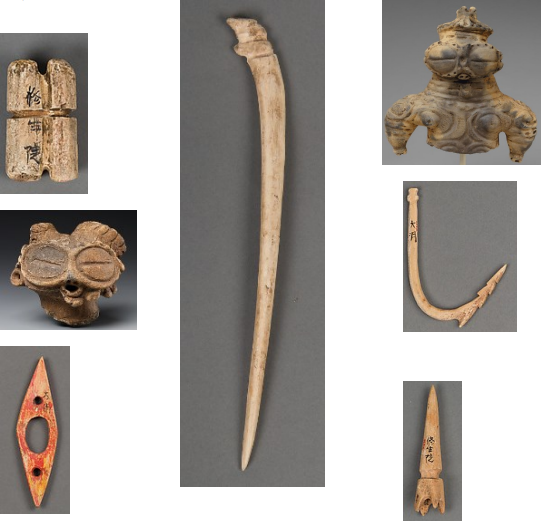1.4: Jewelry, Trade, and Hierarchy
- Page ID
- 135103
One thing clearly links us with the people of the deep past: our love of adornment. The salmon-eating Jomon people of 13,000 BC on the archipelago made earrings of talc stone and jade pendants, and their imaginative clay figurines of people also wear jewelry. They travelled between the islands and the peninsula in dugout wooden canoes to trade shell bracelets and hard, shiny obsidian (volcanic glass). People everywhere have always treasured jewelry, preferably made of exotic materials that were beautiful and hard to obtain. Indeed, current theory holds that the Agricultural Revolution was motivated by trade: People wanted to settle down in places along natural trade routes, particularly navigable rivers, and they wanted to be able to support artisans who could make things to trade for things from elsewhere. Trade and travel, fundamental drivers of history, have spread objects and ideas across Eurasia and North Africa for 20,000 years. Often, as we shall see, trade objects reinforced or led to social inequality.

The trouble with owning nice things from far away, and storing fish or grain to last over the winter, is that someone can take those things away. By 2000 BC, Neolithic villagers in the Yellow River area were building rammed-earth walls around their villages, some 20 feet high and 30 feet thick. To coordinate defense, some villagers took on leadership roles, so social hierarchy began to appear. Archaeologists trace the growth of inequality among members of a community through burials. In Yangshao cemeteries, about 4500 BC, people buried each dead person with roughly equal quantities of utensils and food. One little girl’s grave in Banpo village contained three well-polished balls for playing with. Sacrificial pits ringed the whole area, suggesting that sacrifices were made to the dead as a whole group, for the good of the whole living community. By two millennia later, however, in a Longshan culture cemetery from about 2500 BC, 600 small graves with few or no objects in them clustered around 80 medium-size graves and only six large tombs. The dead in the medium-size graves had wooden coffins, pottery vessels, ornaments of various materials, and ritual objects (cong tubes and pig mandibles). The large tombs contained whole sets of pottery vessels and musical instruments made out of wood, crocodile skin, and copper, and their walls were painted with murals. All this means that in the late Stone Age mainland some villagers had more power and prestige than their neighbors.
Likewise, by 2,000 BC, large towns with massive protective walls built by thousands of workers were made possible by the irrigated rice agriculture of the central Yangzi (Hunan), where the state of Chu developed. In the peninsula and archipelago, dramatic social differentiation came later, accompanying the use of metals: bronze technology reached the peninsula only in about 700 BC, initially in the form of mirrors and daggers from the mainland; and in the archipelago bronze and the later iron technology arrived about the same time, 300 BC. Metal came to the peninsula and archipelago from the mainland, like domesticated rice. But that was only the easternmost end of a much longer travel route.
Metallurgy had reached the mainland from the west, from Persia (Iran and Afghanistan) and Central Asia (Kazakhstan, Kyrgyzstan, Tajikistan, Turkmenistan, and Uzbekistan). Sometimes the route is called “the steppe bridge,” because it crossed the flat plains of Central Asia, Mongolia, and Manchuria. Sometimes it is called “the Silk Road(s),” a term invented by German scholars in the nineteenth century.8 The Silk Roads also connected East Asia with South Asia (also called “the subcontinent,” i.e. India, Pakistan, and Bangladesh). Apples and apricots originated in Central Asia, and many of our foods – including wheat, millet, oats, grapes, almonds, tea, melons, lentils, dates, pistachios, and peaches – travelled across the Silk Roads.9 The area provided East Asia with luxury items like gold and jewels, and ideas including various kinds of technology, religion, and artistic styles from at least 3000 BC onwards. The steppe route shaped East Asian history, as we shall see over and over again.


